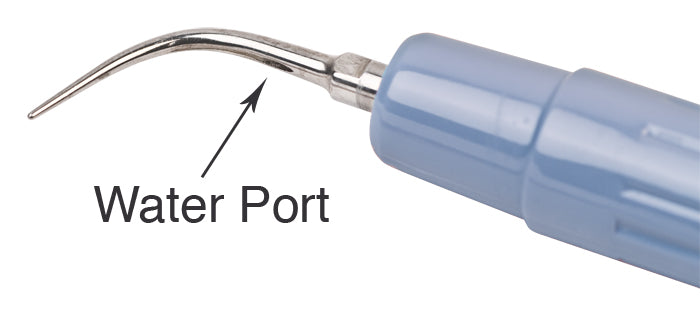Even with proper protocols in place (i.e. the correct treatment and filtration), clogs still occur in your water lines. This Practice Tip focuses on one of the most commonly clogged devices, the ultrasonic scaler (Cavitron™). We will show you how to restore flow to your ultrasonic scaler to get your practice up and running again!
We went over the importance of ultrasonic scaler maintenance a few years ago, and even further back in Practice Tips #18 we covered waterline clogs: how to recognize if you have one and what to do about it. Using a self-contained water system gives you better control of water quality and helps you treat the lines to inhibit biofilm growth in accordance with ADA guidelines (see Practice Tips #55 and #56).
Biofilm build-up is still a very common cause of clogs in dental unit water lines. Ultrasonic scalers have very small water lines and generate a tremendous amount of heat, making them ideal breeding grounds for biofilm. We see and hear of more clogs in ultrasonic scalers than any other device.
Clog Behavior
As discussed back in PT #18, one of two behaviors will typically be exhibited if you have a clog:
- No water flow (as you might expect) or
- A normal flow that starts off fine and then trickles off to nothing.
The latter is the most common behavior of a clogged line. It’s rare for lines to get completely blocked. Typically, flow is restricted (but not completely blocked), so pressure builds up when the unit is not in use and you get good flow at first. The obstruction prevents good flow, so the water flow rapidly drops off to near nothing. Once you’ve determined you have a clog, how do you proceed?
Fixing a Clog
First, determine the location of the clog. Is it in the scaler tip or in the unit? To find out, remove the tip and run the unit. Do you get water out of the handle without a tip in place? Does the water flow for a long time uninterrupted? If so, the clog is in the scaler tip.
Clog in the Scaler Tip
You can attempt to clean the water passage of the tip with a handpiece cleaning wire or similar small stiff wire. Blowing air backwards through the tip (you can use our etcher adapter or an air/water syringe) will free up anything in the lines. Be sure to wear safety glasses whenever attempting to blow out debris. An endodontic file or barbed broach also helps to mechanically clean the tip.

PHOTO: This ultrasonic scaler tip has a water port underneath and is where a clog is possible. (#59-T91 is shown above)
Clog in the Unit
If the clog is in the scaler unit (i.e. no water comes out of the handle with no tip installed), try blowing out the line. Again, work from the end backwards as debris usually works its way in from the opposite direction. Before applying air, turn the unit on and step on the foot control to open up the solenoid, so the air (and debris) has somewhere to go.
Make sure to disconnect the water line from the back of the unit. An air flush of this nature takes some time, so let the air run for several minutes. If this does not remove the obstruction, you may need to replace the solenoid. American Dental Accessories, Inc. carries several replacement solenoids for specific models of Cavitron™ brand scalers.
Flushing Your Scaler
You can attempt to flush the unit with a water line cleaner too. Connecting the unit directly to a self-contained water system is the easiest method of accomplishing this. Another way to flush it is with a simple syringe to introduce a solution into the line. Flush the line as you would flush the socket of a freshly extracted tooth.
Removing the obstruction from an ultrasonic scaler is really the same as removing the obstruction from any other line. If you can access the entire line, using an object to free the line (like a wire) is usually a good option. If not, use high-pressure air to blow the obstruction out. Solutions help to break down the obstruction to more easily remove it.

PHOTO: A typical inline water filter used on ultrasonic scalers (see #49-57)
To prevent clogs from happening check and change your filters regularly. Use self-contained water systems to treat the water. Cleaning and sterilizing your ultrasonic tips between patients helps tremendously in preventing clogs from forming in the first place. Clogs can happen, but by following the steps above, you can clear your lines, restore flow to your ultrasonic scaler, and be back in business in no time.

LEAVE A REPLY